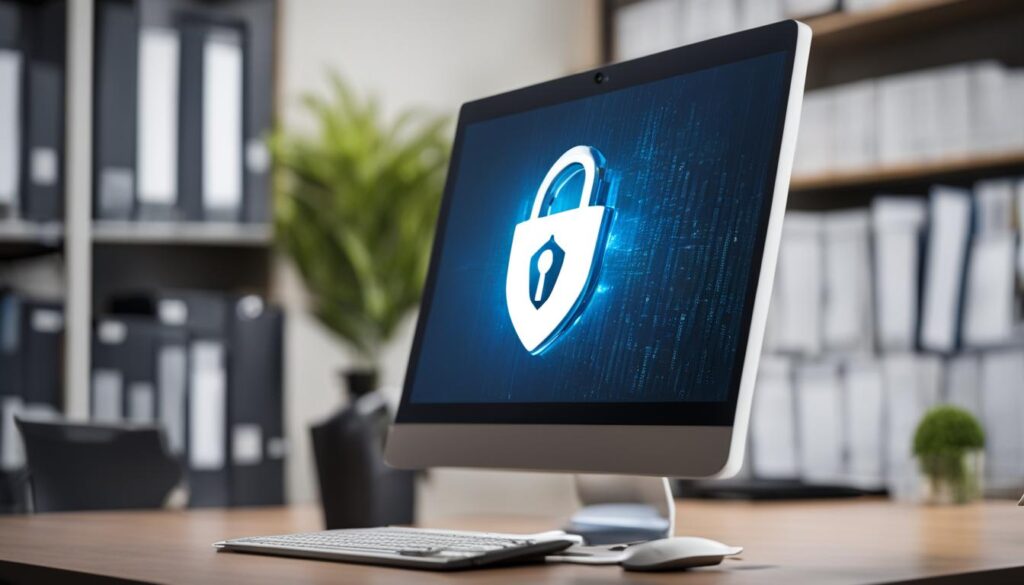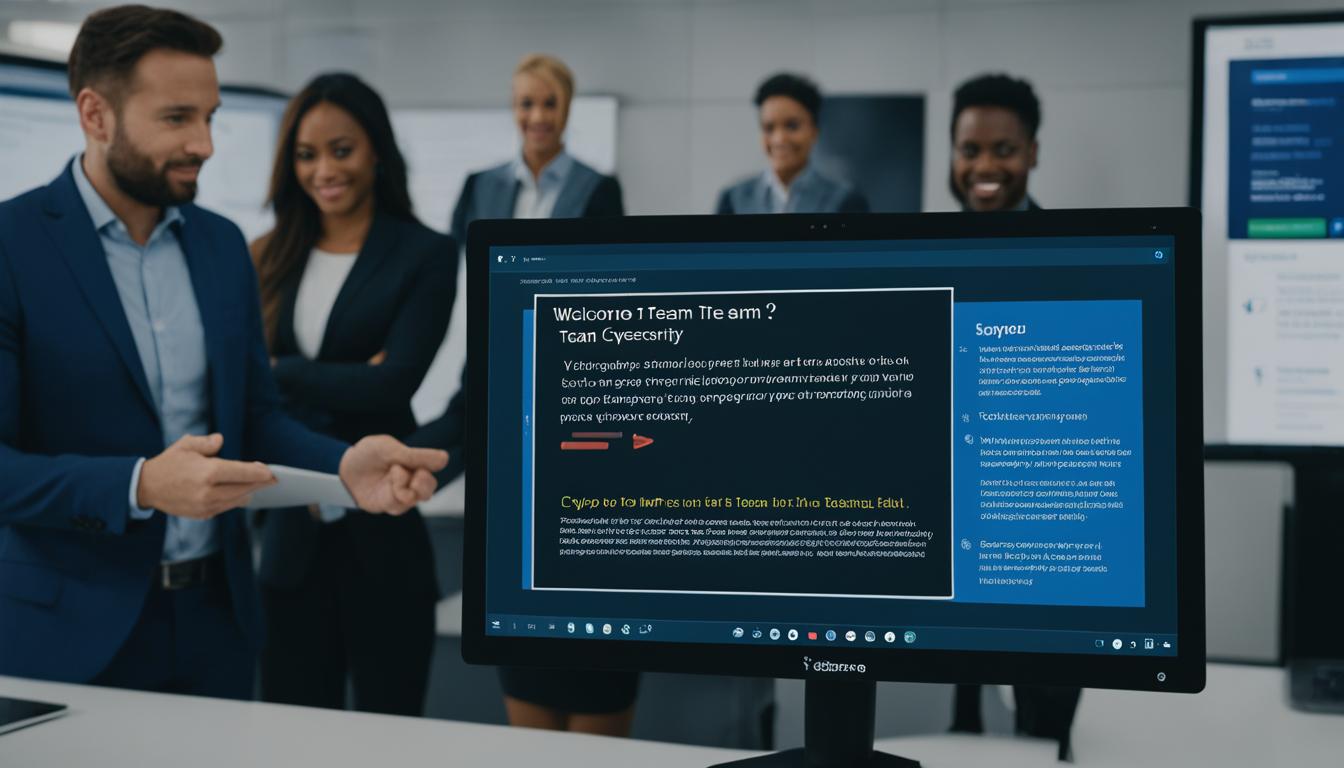Welcome to the digital age, where data protection is more important than ever. As organizations rely heavily on technology and digital assets, the need for cybersecurity training during the employee onboarding process becomes paramount. By incorporating cybersecurity training from day one, you can ensure the protection of company data and foster a culture of security consciousness among your employees.
During the onboarding phase, new hires have the opportunity to learn about their role, company policies, and the organization’s values. It is also the ideal time to instill a sense of responsibility and ownership regarding cybersecurity practices. By providing comprehensive training on cybersecurity, you can empower your employees to identify potential threats, follow security protocols, and contribute to the overall protection of your organization.
Clearly defined policies and procedures play a crucial role in the development of a robust cybersecurity framework. When employees understand what is expected of them, they are more likely to adhere to company policies and integrate cybersecurity practices into their daily routines. By incorporating structured cybersecurity training into the onboarding process, you establish a strong foundation for your employees, allowing them to make informed decisions and take proactive measures to safeguard company assets.
Key Takeaways:
- Cybersecurity training is essential during the employee onboarding process to protect company data and digital assets.
- The onboarding phase is an opportunity to instill responsibility and ownership for cybersecurity practices.
- Clearly defined policies and procedures contribute to the development of robust cybersecurity practices.
- Structured cybersecurity training should be included in the onboarding checklist for new employees.
The Importance of Cybersecurity Awareness Training
Cybersecurity awareness training is an essential part of ensuring the security and protection of your company’s data and assets. Just as we teach children about personal hygiene to maintain a healthy environment, training employees on cybersecurity best practices is crucial for maintaining a secure digital environment.
By providing cybersecurity awareness training, you can increase your employees’ understanding of the rationale behind security policies and their role in protecting company data and privacy. This training helps them develop good security hygiene and follow cybersecurity best practices in their everyday work.
A key aspect of cybersecurity awareness training is educating employees on phishing awareness. This includes teaching them how to identify and avoid suspicious emails, text messages, and phone calls that may be used to gain unauthorized access to sensitive information. By empowering employees with knowledge, you can significantly reduce the risk of falling victim to phishing attacks.
Physical security measures are also an important part of cybersecurity awareness training. Employees should be aware of the significance of not propping open doors or using unsecured storage devices, such as USB drives, that can be easily lost or stolen.
By implementing comprehensive cybersecurity awareness training, you can create a workforce that is well-equipped to protect your company from cyber threats and contribute to a culture of security.
Establishing Reporting Procedures and Training Advocates
Creating a culture of proactive security threat reporting is vital to ensure the early detection and mitigation of potential cyber threats. By implementing clear reporting procedures, you can encourage employees to report suspicious activities promptly. This empowers your team to play an active role in safeguarding your organization’s digital assets and sensitive information.
One effective strategy to promote cybersecurity awareness and vigilance among employees is to establish cybersecurity training advocates within your organization. These advocates can serve as mentors and resources, keeping employees informed about the latest threats and best practices.
Additionally, managing user privilege access is crucial for maintaining the security of your systems. By implementing the principle of least privilege, employees are granted access only to the resources necessary for their roles. This significantly reduces the risk of unauthorized access and potential data breaches.
Training Advocates: Mentoring Your Team
Cybersecurity training advocates can act as mentors, guiding employees on how to recognize and respond to potential security threats. These advocates can educate their peers about the importance of strong passwords, secure browsing habits, and the dangers of phishing attempts. By fostering an environment of knowledge sharing, your organization can create a collective defense mechanism against cyber threats.
Password Protection: Strengthening the Frontline
One of the most common causes of data breaches is compromised credentials. Therefore, educating employees on password protection practices is essential. Cybersecurity training should emphasize the importance of using strong, unique passwords and regularly updating them. Encouraging the use of password managers can help employees efficiently manage their login credentials and reduce the risk of password-related security incidents.
Below is an image that represents the importance of establishing reporting procedures and training advocates:

By establishing reporting procedures and training advocates, you empower your employees to be proactive in identifying and reporting potential security threats, while also emphasizing password protection as a frontline defense against cyber-attacks.
Secure Remote Work Practices
As remote work becomes increasingly prevalent, it’s important to implement specific cybersecurity measures to ensure the security and privacy of company data. To protect sensitive information, there are several key practices that employees should follow:
1. Use a Company-Approved VPN
When remotely connecting to company servers and data, it is essential to use a trusted and secure virtual private network (VPN). A VPN creates a secure connection between the employee’s device and the company’s network, encrypting data and protecting it from potential threats. By using a company-approved VPN, employees can ensure that their remote work sessions are secure and their data remains confidential.
2. Emphasize Secure App Usage
Employees should be instructed to limit their app usage to approved applications for accessing company resources. It is important to prevent the use of unauthorized apps, as they may introduce vulnerabilities and compromise security. By adhering to strict app usage guidelines, employees can mitigate the risk of data breaches and other security incidents.
3. Establish BYOD Guidelines
Bring Your Own Device (BYOD) policies should be established to address the use of personal devices on the company network. These guidelines should ensure compliance with security requirements and protect against potential threats. By clearly defining the acceptable use of personal devices and implementing appropriate security measures, companies can minimize vulnerabilities associated with BYOD and maintain a secure remote work environment.
Implementing secure remote work practices is vital in today’s digital landscape. By using a company-approved VPN, emphasizing secure app usage, and establishing BYOD guidelines, companies can ensure the protection of sensitive data and maintain a secure remote work environment.
Strengthening Password Protection and Device Security
In today’s digital landscape, strong password practices and device security are crucial to protect your sensitive information and maintain the integrity of your devices. By following these best practices, you can significantly enhance your cybersecurity defenses.
1. Use Strong and Unique Passwords
Creating strong and unique passwords is the first line of defense against unauthorized access. Use a combination of letters, numbers, and symbols to create complex passwords. Avoid using easily guessable information such as birthdates or common words. Additionally, ensure that each of your accounts has a unique password to prevent a single breach from affecting multiple accounts.
2. Implement Safe Password Storage Practices
Securely storing your passwords is just as important as creating strong ones. Consider using password managers, which encrypt and store your passwords in a centralized location, protected by a master password. This eliminates the need to remember multiple complex passwords while maintaining the security of your accounts.
3. Protect Your Devices with Lock Screen Passcodes
Set up lock screen passcodes on your devices, including smartphones, tablets, and laptops. This adds an extra layer of protection, ensuring that only authorized individuals can access your device. In case of a lost or stolen device, reporting it immediately to your IT department or the appropriate authorities is crucial to prevent unauthorized access to your data.

4. Practice Secure File Sharing
When it comes to file sharing, avoid using USB drives, as they can be easily lost or stolen. Instead, opt for secure alternatives such as encrypted email, network drives, or cloud storage solutions. These options provide better control and protection of your files, minimizing the risk of unauthorized access or data breach.
By implementing these strong password practices and device security measures, you can significantly reduce the risk of falling victim to cyber threats and protect your valuable information.
Incorporating Security Policies and Compliance Training
When it comes to cybersecurity, having robust security policies and compliance training is crucial for organizations to protect their data and maintain regulatory requirements. In this section, we will explore the importance of incorporating security policies and compliance training into the employee onboarding process.
During the onboarding phase, it is essential to provide new hires with a comprehensive review of the company’s security policies and procedures. This includes educating them about relevant industry regulations and governmental protocols that impact the organization.
Employees should receive thorough training on data privacy and protection, with an emphasis on incident reporting and compliance with relevant regulations. By equipping employees with the knowledge and understanding of security and compliance policies, organizations can ensure that everyone is aligned with best practices and understands their role in maintaining a secure environment.
Practical examples and exercises can be incorporated into the training to reinforce policy understanding and encourage employees to practice good security hygiene. This hands-on approach can increase engagement and help employees apply the policies in real-world scenarios.
To foster a culture of security and compliance, clear communication channels should be established for reporting incidents and accessing support. This creates a safe and supportive environment where employees feel empowered to speak up about potential security challenges and seek assistance when needed.
Providing comprehensive security policies and compliance training during onboarding sets the foundation for a resilient cybersecurity program. By prioritizing security and compliance from the start, organizations can mitigate risk, protect sensitive data, and ensure ongoing compliance with industry regulations.
Conclusion
An effective cyber security onboarding program is essential for organizations to safeguard their valuable data and foster a solid security culture. By incorporating cyber security best practices, secure remote work practices, and strong password protection into the onboarding procedures, companies can lay a strong foundation for cyber security awareness and vigilance among their employees.
During the onboarding process, it is crucial to provide employees with comprehensive cyber security training and guidelines. This includes educating them about the importance of identifying and reporting security threats promptly. By establishing clear reporting procedures and appointing cyber security training advocates, organizations can ensure that employees have the necessary support and resources to address potential cyber security risks.
However, cyber security onboarding should not stop at initial training. Continuous education and training programs should be implemented to keep employees updated about the latest cyber security trends, emerging threats, and industry best practices. This ongoing commitment to cyber security awareness and knowledge empowers employees to become the first line of defense against cyber threats, protecting both company data and customer privacy.
By prioritizing cyber security onboarding and fostering a culture of security-consciousness, organizations can mitigate the risks posed by cyber attacks and create a resilient cyber security posture. Incorporating a thorough cyber security onboarding checklist into the onboarding process ensures that every new employee receives the necessary training, guidelines, and resources to contribute to a secure and protected digital environment.
FAQ
How can I include cybersecurity training in the employee onboarding process?
Cybersecurity training should be included in the onboarding checklist for new employees. This ensures that they receive the necessary education on cybersecurity best practices and helps instill a sense of responsibility and ownership for maintaining a secure environment.
Why is cybersecurity awareness training important?
Cybersecurity awareness training is comparable to teaching personal hygiene to children. It emphasizes the importance of maintaining a healthy and secure environment. By training employees on cybersecurity best practices, they will have a better understanding of the rationale behind policies and their role in protecting company data and privacy.
How can employees identify phishing attempts?
Phishing awareness is a crucial aspect of cybersecurity training. Employees should be educated on how to identify suspicious emails, text messages, and phone calls. They should be cautious of clicking on unknown links or providing sensitive information to unknown sources.
What physical security measures should employees be aware of?
Employees should be aware of physical security measures such as not propping open doors or using unsecured storage devices like USB drives. These simple actions can help prevent unauthorized access and potential security breaches.
How can employees report suspicious activity?
It is important to establish a clear procedure for reporting suspicious activity to encourage employees to report potential security threats. This can include a dedicated reporting channel, such as an email address or incident reporting system, where employees can confidentially share their concerns.
How can training advocates support employees?
Cybersecurity training advocates can act as mentors and resources for employees. They can help employees stay informed about the latest threats and best practices, answer questions, and provide guidance on security-related issues.
Why is user privilege access management important?
Managing user privilege access ensures that employees only have access to the resources necessary for their job. By implementing proper access controls, organizations can reduce the risk of unauthorized access and potential data breaches.
What measures should be taken for secure remote work?
Remote work requires specific cybersecurity measures to ensure data security and privacy. Employees should be instructed to use a company-approved virtual private network (VPN) when remotely connecting to company servers and data. Secure app usage should also be emphasized to limit access to approved apps for accessing company resources and prevent the use of unauthorized apps.
How can employees strengthen password protection and device security?
Employees should be trained on setting strong passwords, using longer passphrases, and unique passwords for each account. Safe password storage practices, such as using password managers and secure encryption, should also be emphasized. Devices should be protected with lock screen passcodes, and employees should be encouraged to report lost or stolen devices immediately.
What file sharing practices should be promoted?
Safe file sharing practices include avoiding the use of USB drives and instead utilizing secure email, network drives, or cloud storage options. This helps ensure that sensitive information is not accidentally exposed or lost.
What aspects of security and compliance should be covered in onboarding?
Onboarding should include a comprehensive review of security and compliance policies. This includes industry and governmental protocols that impact the organization. Employees should receive training on data privacy and protection, incident reporting, and compliance with relevant regulations.
How can companies empower employees to handle security challenges?
Companies can establish clear communication channels for reporting incidents and accessing support. This ensures employees feel supported and equipped to handle potential security challenges. Continuous education and training should also be provided to keep employees informed about the latest cybersecurity trends and best practices.




